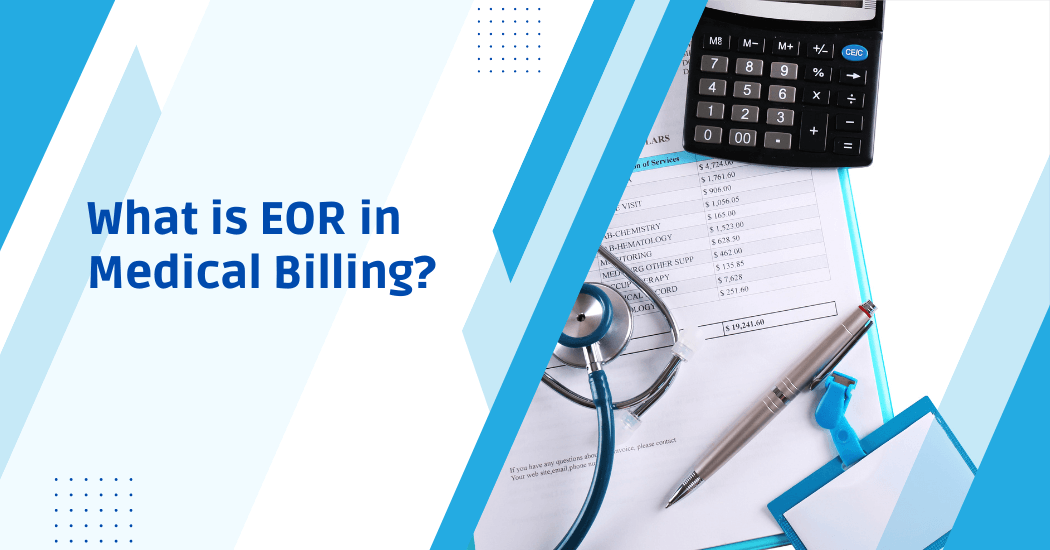What is EOR in Medical Billing?
You’ve likely seen references to ‘EOR’ scattered throughout your medical billing work, but what exactly does it mean? The acronym EOR, which stands for ‘Explanation of Reimbursement,’ is a key term in medical billing that is important to understand properly. As medical billers and coders, we often come across EOR in the context of insurance claim submissions and reimbursements. However, its full significance is sometimes unclear.
In this post, I aim to provide a comprehensive overview of what an EOR is, the different forms it can take, how insurers use EORs and what EORs mean for your daily billing tasks and workflows. A clear grasp of EORs will help you navigate the reimbursement process with greater confidence and efficiency.
Understanding the Basics of EOR
At its core, an Explanation of Reimbursement (EOR) is a document sent by an insurance company to the provider, detailing the services billed, the payment made and the reasons for any differences between the billed amount and the paid amount. It offers a breakdown of how the insurance company calculates the reimbursement for a particular service.
This includes details such as the initial amount billed, any applied discounts, covered and non-covered services, patient responsibility portions like copays or deductibles and the final reimbursement amount. The EOR thus serves as a vital tool for provider offices to reconcile their billing records, understand payment decisions and identify any necessary follow-ups with the insurer or the patient. Understanding EORs requires familiarity with common terminology and the ability to interpret various codes and modifiers. Next, let’s look at the different forms an EOR can take.
Types of EORs
Depending on the type of health insurance plan and specific payment arrangements between a provider and the insurer, EORs can come in various formats. Some examples include:
- Standard Paper Explanation of Benefits (EOB) – This is a traditional paper document sent through mail or fax. It includes detailed information about the services provided, the billed amount and how much the insurer paid.
- Electronic Remittance Advice (ERA) – This digital document is transmitted through electronic data interchange (EDI) format. It contains similar information as a standard EOB but in a more standardized and structured layout for easier processing and record-keeping.
- Online Portals – Many insurance companies now offer online portals for providers to access EORs and other claim-related information. These portals often allow providers to search, filter and download EORs for multiple patients at once.
Significance of EOR in Medical Billing
The Explanation of Reimbursement (EOR) is significant in medical billing for several reasons:
- Communication: The EOR serves as a crucial communication tool between insurance companies and healthcare providers, explaining the insurer’s payment decisions in detail.
- Reconciliation: It allows healthcare providers to accurately reconcile their billing records with the payments received from insurance companies.
- Discrepancy Identification: Any discrepancies between the amount billed for services and the amount paid by the insurer are highlighted in the EOR, enabling providers to identify and rectify any billing errors.
- Denial Management: The EOR provides valuable information about denied claims, helping healthcare providers manage denials more effectively and resubmit claims if necessary.
- Patient Billing: The EOR outlines patient responsibility portions, aiding providers in accurately invoicing patients for their share of the healthcare costs.
- Record Keeping: Whether in paper or electronic form, EORs serve as important records for audit purposes and future reference.
- Efficiency: Electronic EORs, in particular, can significantly improve the efficiency of the billing process by reducing administrative costs and expediting payments.
The Process of Generating EOR
The process of generating an EOR begins when a healthcare provider submits a claim to the insurance company. The insurer reviews the claim details, verifies the patient’s coverage and decides the amount to be paid for each service based on established rate schedules and contract agreements. The insurer then generates the EOR, encapsulating all the relevant details including the services billed, the calculated payments and any adjustments or denials, if applicable.
The EOR is typically generated automatically by the insurer’s claim management system. The system is configured to apply the relevant billing rules and calculations, ensuring that the EOR accurately reflects the insurer’s payment decision. Once generated, the EOR is sent to the provider in the agreed-upon format, which can be a paper document, an electronic remittance advice, or an online portal update.
The provider office receives the EOR and reviews the remittance details. If there are any discrepancies between the amount billed and the amount paid, the EOR will highlight these differences and provide explanatory codes or comments. The healthcare provider can then use this information to adjust their billing records, resubmit any denied claims if necessary and invoice the patient for any unpaid portions. Overall, the EOR is a crucial communication tool between insurers and healthcare providers in the reimbursement process.
Electronic vs. Paper-based EORs
In recent years, electronic EORs have become the preferred method of communication between insurers and healthcare providers. This shift from traditional paper documents to electronic formats is driven by cost-saving measures, streamlined processes and improved data accuracy. Electronic EORs reduce administrative overhead costs associated with printing, mailing and processing paper documents. They also provide a faster turnaround time for payments and allow for easier tracking and reconciliation of claims.
On the other hand, paper-based EORs have their benefits, such as being more accessible to providers with limited technological resources or those who prefer physical documents for record-keeping purposes. However, with the increasing use of electronic health record systems and online portals, paper-based EORs are becoming less common in medical billing.
Challenges and Issues Related to EOR
Despite the importance of EORs in the medical billing process, they are associated with several challenges and issues.
- Complexity of Codes and Terminology: EORs often use specialized billing codes and industry-specific terminology, which can make them difficult to understand for individuals unfamiliar with medical billing. This complexity can lead to misunderstandings and misinterpretations.
- Discrepancies in Amounts: Sometimes, discrepancies may arise between the billed amount and the paid amount. Such discrepancies need to be identified and addressed promptly, which can be time-consuming.
- Denials Management: Dealing with denied claims, especially without clear explanations, can be a daunting task for many healthcare providers. It requires a deep understanding of the denial codes and the ability to effectively contest denials.
- Transition to Electronic EORs: While electronic EORs offer many advantages, the transition from paper to digital formats can create challenges for healthcare providers. They may need to invest in new technologies and train their staff to use them effectively.
- Data Privacy Concerns: As with all digital health data, electronic EORs need to be protected to maintain patient confidentiality and comply with data privacy laws. Ensuring data security can be a significant challenge for many healthcare providers.
- System Compatibility Issues: Not all claim management systems are compatible with each other. This may lead to issues when providers attempt to process EORs from different insurers with their own system. It is essential to ensure that systems can communicate and exchange data seamlessly.
Tips for Efficient EOR Management
Efficient management of EORs can significantly streamline the medical billing process. Here are some tips that healthcare providers can adopt:
- Understand Billing Codes and Terminology: Invest time in understanding the different billing codes and industry-specific terminology used in EORs. This will minimize misunderstandings and errors in claim submission and reconciliation.
- Use Modern Billing Software: Utilize modern billing software that can easily interpret EORs, reconcile payments and highlight discrepancies. The software should also have capabilities to handle denials and resubmission of claims effectively.
- Ongoing Staff Training: Continuous training of billing staff is crucial. They should be made aware of the latest changes in billing regulations and codes. This will ensure accurate processing and interpretation of EORs.
- Maintain Secure Digital Records: Store EORs securely in a digital format. This not only saves space but also makes it easier to retrieve records when needed. However, ensure all data is stored in compliance with data privacy laws.
- System Compatibility: Use a claim management system that is compatible with different insurers. This will allow for a smoother exchange of data and reduce processing times and errors.
- Clear Communication with Insurers: Maintain clear and open communication with insurance companies. This could help resolve any issues with the EORs promptly and improve the overall billing process.
- Regular Auditing: Regular auditing of the EOR process can help identify any bottlenecks or areas of improvement. This can lead to more accurate billing and better financial management.
Future Trends in EOR that Healthcare Providers Should Watch Out
Automation in EOR Management
The future of EOR management lies in automation. As technology continues to evolve, the healthcare industry is witnessing an increasing adoption of automated systems for managing EORs. These systems are designed to automatically process EORs, identify discrepancies, handle denials and reconcile payments. This not only speeds up the billing process but also reduces the likelihood of errors. Automation also frees up staff time, allowing healthcare providers to focus more on patient care rather than administrative tasks.
Integration of AI and Machine Learning
Artificial Intelligence (AI) and Machine Learning (ML) are expected to play a significant role in EOR management. These technologies can learn from data patterns and make predictions, which can be particularly useful in identifying billing errors and fraud. They can also help automate the process of decoding complex billing codes, making EORs easier to understand and manage.
Increased Use of Blockchain Technology
Blockchain technology is another trend that is likely to shape the future of EOR management. Blockchain’s decentralized and transparent nature can help ensure the integrity and security of EOR data. It can also streamline the reconciliation process, as every transaction is recorded and can be easily tracked and verified.
Enhanced Data Security Measures
As the use of electronic EORs continues to rise, so does the need for robust data security measures. Future trends in EOR management will likely involve enhanced data encryption methods and stringent access controls to protect patient information. Furthermore, the use of advanced technologies such as biometrics for authentication may also become common in the future.
Standardization of EOR Systems
Standardization of EOR systems is another trend that is expected to shape the future of EOR management. This involves creating a universal standard for EOR formats and codes, making it easier for different healthcare providers and insurers to communicate and exchange data. Standardization can help reduce system compatibility issues and improve the overall efficiency of the billing process.
Conclusion:
EOR in medical billing is an essential process that plays a crucial role in ensuring accurate and timely reimbursement for healthcare services. We have explored the definition and purpose of eor, as well as its importance in avoiding claim denials and delays. Additionally, we have discussed the different types of eor, including electronic and manual options.
It is clear that having a thorough understanding of eor is crucial for medical billers and coders to perform their jobs effectively. Therefore, it is important for professionals in the healthcare industry to stay updated on any changes or updates related to this process.
With advancements in technology, we can expect to see further improvements and enhancements in eor systems in the future. Stay informed and knowledgeable about eor to ensure success in your medical billing career.






